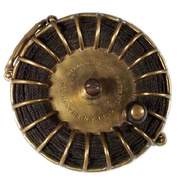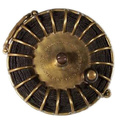Interview courtesy of the Ephemera Blog, Marty Weil’s great information resource on ephemera collecting and collectors, and a member of our Hall of Fame. Rob Pavey’s site Mrlurebox.com is also a member of our Hall of Fame.

Rob Pavey, a full-time writer and outdoors columnist with the Augusta (Georgia) Chronicle, lives in Evans, Georgia, with his wife, three sons, and a bloodhound named Daisy. He has been a member of the National Fishing Lure Collectors Club more than 20 years and has authored or contributed to three reference books on antique fishing tackle. We discuss the world of old lures in the following interview:
Q: Old lures are truly works of art. And fishing is one of my favorite outdoor sports. I love ultra-light bass fishing. I’ve had the pleasure of spending many hours on the water, and I’m really interested to hear about your collection. How’d you become a lure collector?
 A: As a child, I really admired my grandfather. In a closet beneath the stairwell that led to his basement, he kept all his fishing gear. Sometimes he would pull it out and take me and the other grandkids fishing. To a tiny child, the fishing trips were exciting – and so were the tackle boxes loaded with lures and gear. By the time I was a teenager, I was interested in antique lures, and when grandad died, I inherited the few wooden baits he still had in his fishing closet. It was the beginning of what has become a lifelong fascination with lures, lure collecting, and the history and culture that helped shape America’s recreational fishing tackle industry.
A: As a child, I really admired my grandfather. In a closet beneath the stairwell that led to his basement, he kept all his fishing gear. Sometimes he would pull it out and take me and the other grandkids fishing. To a tiny child, the fishing trips were exciting – and so were the tackle boxes loaded with lures and gear. By the time I was a teenager, I was interested in antique lures, and when grandad died, I inherited the few wooden baits he still had in his fishing closet. It was the beginning of what has become a lifelong fascination with lures, lure collecting, and the history and culture that helped shape America’s recreational fishing tackle industry.
It has also been a hobby that has given me countless close friends, which is what makes lure collecting even more special. It’s also important to note that fishing is the great American pastime. Unlike pro football or the World Series, fishing is something you do and enjoy–not something you watch. In the world of collectibles, can you imagine any collection that holds more fun memories than a display of antique lures from the golden age? Just think of the stories the men who fished together and used all these baits might have swapped while casting for walleye or largemouths at their favorite lake. Best of all, the availability of old lures is almost limitless, and quality collections can be assembled for almost every income level. Fishing with wooden lures is a uniquely American invention. Spoons, spinners, and flies were devised in Europe, but wooden lures that entered the market around 1900 were both artistic and utilitarian. Their appeal and availability–and high price at the time–made them a wealthy man’s sport in the beginning, and eventually everyone fished with lures. The important fact is that the lures we collect today helped create the transition of fishing from a sustenance activity to a recreational pastime. Lures helped fuel the rise of recreational sportfishing that has become so huge today.
 Q. (Weil/ephemera): I’ve bought a lot of lures over the years. A personal favorite is Fred Arbogast’s Hula-Popper. I love the names of the lures. One night, while top-water fishing for bass with a group of friends on a remote Michigan lake, we laughed ourselves silly over the names of different lures. We were punchy, and the names–like Eureka Wiggler, Hula-Popper, and Hoot-a-Nanny–just struck us as very funny. I’ll never forget how much fun that was. I caught a three-pound bass that evening on a skirted Hula-Popper, it was magic. Tell me about your collection and the obstacles you encounter as a lure collector.
Q. (Weil/ephemera): I’ve bought a lot of lures over the years. A personal favorite is Fred Arbogast’s Hula-Popper. I love the names of the lures. One night, while top-water fishing for bass with a group of friends on a remote Michigan lake, we laughed ourselves silly over the names of different lures. We were punchy, and the names–like Eureka Wiggler, Hula-Popper, and Hoot-a-Nanny–just struck us as very funny. I’ll never forget how much fun that was. I caught a three-pound bass that evening on a skirted Hula-Popper, it was magic. Tell me about your collection and the obstacles you encounter as a lure collector.
A. (Pavey): The biggest challenge in lure collecting is deciding what to collect. It is a fascinating hobby and certain collectors focus on odd things. Some guys collect only frog lures, or mechanical/spring-loaded baits, or lures in a certain paint color, like green crackleback or redhead/white body. Some people collect fly-rod lures–or they might specialize in lures made in their particular home state. Some of the West Coast collectors compete for rare salmon baits. Some people collect it all–and that can be difficult. Challenges in lure collecting can include finding things to add to your collection, or perhaps networking to help meet fellow collectors to trade and buy/sell with. As far as overcoming challenges, the Internet, eBay, many wonderful new reference books and dozens of regional and national antique lure shows and swap meets all over the country are all quite helpful.
 Q. (Weil/ephemera): What are your favorite items in your collection?
Q. (Weil/ephemera): What are your favorite items in your collection?
A. (Pavey): My Collection focuses on early lures in their original boxes. The “Big Five” companies–Heddon, Creek Chub, Shakespeare, Pflueger, South Bend and Paw Paw–are the most well known. But there were hundreds of smaller “mom and pop” lure makers over the years that are often much more interesting and challenging to collect. That’s what I like. Best of all, you can never complete such a collection, especially with the boxes from these short-lived makers being very hard to come by. Among all those boxed lures, some of my favorites–and I like the really early stuff–are the Miller’s Reversible Wood Minnow, the
Q. (Weil/ephemera): What’s your advice for achieving success as a collector?
 A. (Pavey): If you want to collect, there are many ways to network. First off, remember that what goes around, comes around. Help other collectors with their collections and others will help you. Be honest in all your trades and transactions. Join the National Fishing Lure Collectors Club and attend some shows. You will learn more than any reference book can teach you and make friends in the process. But you should get a few important books. Carl Luckey’s Old Fishing Lures & Tackle: Identification and Value Guide
A. (Pavey): If you want to collect, there are many ways to network. First off, remember that what goes around, comes around. Help other collectors with their collections and others will help you. Be honest in all your trades and transactions. Join the National Fishing Lure Collectors Club and attend some shows. You will learn more than any reference book can teach you and make friends in the process. But you should get a few important books. Carl Luckey’s Old Fishing Lures & Tackle: Identification and Value Guide is the best all-around reference. Watch for things on eBay, where about 8,000 lures per week are bought and sold. Let all your friends and colleagues know you are collecting lures–and make sure your local estate dealers know you as well. Advertise in the local daily or shopper. I built a website, which has helped me find many nice items. There is no limit to creativity.
Q. (Weil/ephemera): You’ve mentioned a few resources are there others you recommend?
 A. (Pavey): Organizations such as the National Fishing Lure Collectors Club have active membership rosters that fluctuate from 5,000 to 8,000. There are many other clubs, including the Florida Antique Tackle Collectors with about 1,000 members. Some auction houses that cater to collectors of antique lures claim to have mailing lists of more than 20,000–which shows there are many more collectors than members in the lure collector societies.
A. (Pavey): Organizations such as the National Fishing Lure Collectors Club have active membership rosters that fluctuate from 5,000 to 8,000. There are many other clubs, including the Florida Antique Tackle Collectors with about 1,000 members. Some auction houses that cater to collectors of antique lures claim to have mailing lists of more than 20,000–which shows there are many more collectors than members in the lure collector societies.
Q. (Weil/ephemera): This interview has brought back a lot of great fishing memories for me, Rob. Lures are a seldom discussed aspect of ephemera, but they truly belong here as works of art and as wonderful collectibles. Thanks for sharing your expertise with the ephemera blog.
Do you have an article you’d like us to publish as a guest column in The Collectors Weekly? Let us know.

 Trends in Fishing Tackle Collecting
Trends in Fishing Tackle Collecting
 The Fun and Artistry of Antique Fishing Lures
The Fun and Artistry of Antique Fishing Lures Trends in Fishing Tackle Collecting
Trends in Fishing Tackle Collecting Jim Schottenham Casts His Net for Vintage Fishing Reels
Jim Schottenham Casts His Net for Vintage Fishing Reels Mari Tepper: Laying it on the Line
Mari Tepper: Laying it on the Line Nice Ice: Valerie Hammond on the Genteel Charm of Vintage Canadian Costume Jewelry
Nice Ice: Valerie Hammond on the Genteel Charm of Vintage Canadian Costume Jewelry How Jim Heimann Got Crazy for California Architecture
How Jim Heimann Got Crazy for California Architecture Modernist Man: Jock Peters May Be the Most Influential Architect You've Never Heard Of
Modernist Man: Jock Peters May Be the Most Influential Architect You've Never Heard Of Meet Cute: Were Kokeshi Dolls the Models for Hello Kitty, Pokemon, and Be@rbrick?
Meet Cute: Were Kokeshi Dolls the Models for Hello Kitty, Pokemon, and Be@rbrick? When the King of Comedy Posters Set His Surreal Sights on the World of Rock 'n' Roll
When the King of Comedy Posters Set His Surreal Sights on the World of Rock 'n' Roll How One Artist Makes New Art From Old Coloring Books and Found Photos
How One Artist Makes New Art From Old Coloring Books and Found Photos Say Cheese! How Bad Photography Has Changed Our Definition of Good Pictures
Say Cheese! How Bad Photography Has Changed Our Definition of Good Pictures Middle Earthenware: One Family's Quest to Reclaim Its Place in British Pottery History
Middle Earthenware: One Family's Quest to Reclaim Its Place in British Pottery History Fancy Fowl: How an Evil Sea Captain and a Beloved Queen Made the World Crave KFC
Fancy Fowl: How an Evil Sea Captain and a Beloved Queen Made the World Crave KFC
I would like to know about the scripto lighter see through with fishing lures inside of it, I have three of them and would like some info Thank You
I have a lure which is an antique. It was owned by the famous fisherman Gadabout Gaddis. The lure is a Miller Reversable Minnow. It is in good condition. Would you be able to give me an estimate on the value of this lure. Thank you for any help that you can provide.
Regards-David L. Vincent
what is the weirdest or most innapropriate name for a bait that David has ever had or seen.